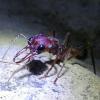Many two-part polyester resins are acutely toxic to ants in both their polymerized and uncured states. Aliphatic resins, in particular, will cause death in minutes, while non-aliphatic polyesters and epoxies may not cause death, but may have some smell or other quality which appears to repel or be less attractive to ants, compared to more natural materials. Thermoplastics and injection-molded components made of ABS, HIPS, PP, PLA, or HDPE are generally more biocompatible.I always conduct small material compatibility tests nowadays, before incrementally moving on to the final intended use, and recommend that others do the same.Additional information:
In the course of my research in designing formicaria for my store,
www.byformica.com, it has been necessary to research the biocompatibility of certain casting resins used in low-volume manufacturing, the most popular of which are 2-part, polyurethane-based resins, due to their extremely low cost and good material properties.
While the depth of my testing has been rather shallow, one thing is very clear:
polyurethane- (or urethane-) based resins, are acutely toxic to small invertebrates, including ants.
I do not have the time, tools, or knowledge necessary to perform in-depth testing as to what chemicals are being released or the mode of entry, but the effect appears to be neurological. Ants, when exposed to
cured polyurethane resins that contain the ingredient "4,4’ Methylene bis (phenylisocyanate) (MDI)," begin to experience irreversible neurological motor impairment (eg. involuntary muscular spasms, loss of muscular control, decrease in sensory response, etc.), eventually resulting in death after one to four hours of exposure, depending on the size of the organism, with smaller ants dying much sooner.
My 16-part study tested whether various post-processing techniques or use factors played a role in speeding or eliminating the toxicological effect of the cured plastic. When no moisture was added, and there was no post-processing of the cured part involved, the ants seemed to fare better, but still eventually died after about 24 hours. Adding a light mist of water to the plastic, cleaning the cured plastic in isopropyl alcohol, coating the plastic with an ethanol-based shellac coating (shellac is not inherently toxic), or performing a combination of the aforementioned, all appeared to greatly increase the speed at which the ants exhibited impairment and eventually died.
The experiment was repeated several times, and all solvents/alcohols were allowed to evaporate completely before ants were introduced to the sample.
- - - - - - - - - -
On the bright side, there are a number of plastic casting resins that may not be toxic to ants. Some promising candidates that I have not had the opportunity to test are some rather exotic water-based resins referred to as "Bio-Plastics" or "Eco-Plastics," some of which use a corn-based hardener, PLA.
However, the industrial-grade plastic I have chosen that does not appear to be toxic to ants is a casting epoxy resin. The resin contains a single potentially harmful component when uncured—"Polyoxypropylene diamine"—which, after curing, does not appear to leech the same or equivalent toxic chemicals that have any acute effect on ant mortality, regardless of exposure to moisture. There are
other casting epoxy resins that do not contain any harmful chemicals (according to the MSDS), whatsoever.
The long-term effects of constant exposure to ants with regard to this epoxy resin have not been studied. This posting will update if there are any new developments.
Hopefully this post will provide insight to anyone looking to design formicaria with plastic casting resins.
Edited by drtrmiller, February 15 2017 - 9:55 PM.

![]() Cheers.
Cheers.